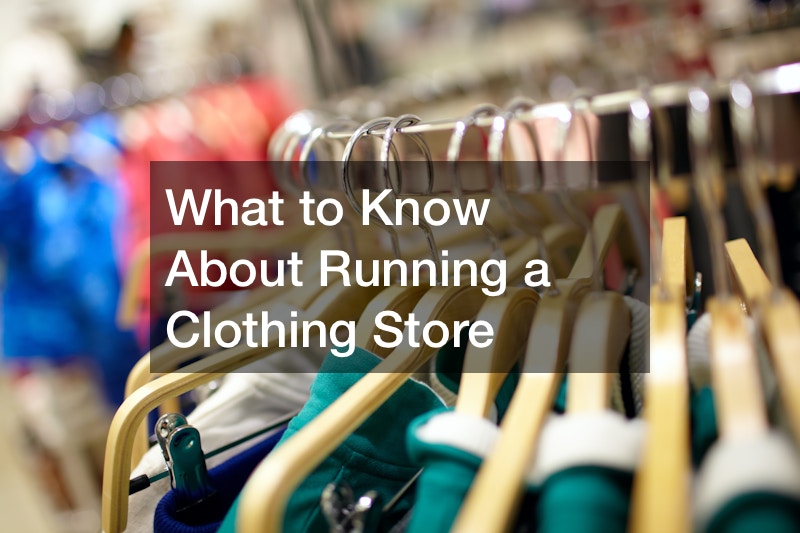What to Know About Running a Clothing Store

Operating a clothing store is rewarding but requires dedication and hard work. You must understand the business’s basics, such as customer service, marketing, and budgeting. Additionally, you must have a good rapport with suppliers and negotiate fair prices. Here are some things you should know about running a clothing store as a storeowner.
Establish Location

As a storeowner, it’s vital to comprehensively understand the various aspects of running a clothing store. One of the crucial factors to consider is establishing a store’s location. Location and the store’s overall atmosphere significantly impact whether a customer opts to do business with you. There are several things to consider when selecting a site for a clothing store. One crucial factor to remember is foot traffic. You must choose a location that gets a lot of foot traffic so potential customers can view your store and come in. Another vital factor to consider is the surrounding businesses around the commercial property. You want to ensure your store’s location is in an area with other companies complementing your own.
The store’s ambiance is also an essential factor to consider. You want your store to have a vibe to attract your target demographic. For instance, if you sell stylish and trendy clothing, your store should have a chic and modern atmosphere. Alternatively, if you’re selling affordable and casual clothing, your store should have a laid-back and relaxed atmosphere. Running a clothing store requires plenty of work but can also be fun. You can have a successful and profitable business with some planning and effort.
Brand Your Services
Your venture’s success depends on your ability to brand your business as the clothing storeowner. A strong brand attracts new customers, giving them a memorable experience, and ensuring your store is the first choice when customers require clothes and accessories. Your clothing store’s brand should be more than a tagline or logo. It should be your store’s identity’s extension and reflect your business’s unique personality and style. When executed correctly, your brand will be the driving force behind every closet organization marketing decision, from the fonts and colors you use on your store and website to how you interact with your customers.
There are several things to remember when branding your clothing store. First and foremost, your brand should be unique. There’s plenty of competition in the fashion industry, so finding a way to stand out is crucial. You can achieve this by differentiating your store based on your store’s physical location, your target market, and the type of clothing you sell. Whatever direction you decide to take, ensure your brand is consistent across all touchpoints, from your social media channels and website to packaging and in-store signage. Branding your services attracts new customers and ensures your store is the first thing potential customers consider when they require clothing and accessories.
Arrange the Store

Running a successful clothing store requires various skills and know-how. Arranging your store is one of the critical elements of running a successful business as a storeowner. When customers visit your store, you want to ensure you draw them in and impress them. Creating a visually appealing and inviting store is one of the ideal ways to do this. You want to create an intuitive flow to guide customers through the store and make it easy for them to find what they want. Strategic placement of essential items can also increase sales. You can also utilize embroidery services to provide attractive, customized clothing to customers and include them in your arrangement.
There are several things to remember when arranging your store. First, you must consider the flow of customer traffic. You want to create a path to guide customers through the store efficiently. Second, you must consider where you’ll place your merchandise. You should put your items in strategic locations to drive sales. Third, you must contemplate how you’ll arrange your inventory. You can organize your items by collection, season, and type. Arranging your store is a crucial aspect of running a successful clothing business. By thoughtfully selecting your displays and layout, you can create a visually appealing and inviting store that makes customers want to return.
Store Upkeep
Successful clothing stores depend on attentive staff, a clean and organized environment, and a well-maintained inventory. A well-kept store is essential for several reasons. First, it creates an impression of quality and professionalism. An organized store with well-maintained displays conveys to customers the store has proper management and is a reliable clothing source. Second, a clean and organized store is more enjoyable and inviting. Customers will likely spend time in and return to a well-maintained store, leading to increased sales. Finally, a well-kept store reflects the clothing quality it sells.
There are several things to remember to ensure your store is well-maintained. First, pay attention to your inventory. Ensure you fold or hang the clothes neatly and stock items in an organized manner. You can also purchase commercial clothes dryers to reduce labor and time, reduce costs, and keep the store running efficiently. Second, keep your sales floor tidy and clean by regularly mopping, sweeping, and dusting. Third, invest in good lighting, as ensuring your store is well-lit makes it feel more spacious, giving the impression of a well-maintained space. Your store’s upkeep is vital to running a successful clothing business as a storeowner. You can create an inviting and professional clothing store by keeping your inventory neat and your sales floor clean.
Outsourcing
As the clothing store industry grows, the need to outsource certain operations and services is a prevalent option for most businesses. Outsourcing allows stores to access technical and cost-efficient services while streamlining their internal processes. One of the significant benefits of outsourcing for clothing stores is accessing a global pool of resources and talent. By working with an outsourced partner, businesses can venture into an extensive scale of resources. It’s particularly beneficial for stores looking to increase production or expand their operations. Additionally, working with a reputable and experienced outsourcing partner can provide store owners peace of mind.
Another benefit of outsourcing is the ability to reduce costs. When stores outsource certain operations, they save on labor costs and other overhead expenses. Sometimes, stores can work with pawn shops to provide access to various second-hand clothing items at discounted prices. Besides lowering costs, outsourcing helps store owners improve their bottom line by increasing productivity and efficiency. Businesses can access resources to expand their operations and reduce costs by working with a reputable outsourcing partner.
Customer Management

A successful clothing store requires more than stocking your shelves with the latest fashion trends. Understanding customer management and establishing relationships with them is vital to ensure customers have a positive experience with your store. While much effort goes into choosing the right accessories and clothing to stock your store, it’s crucial to consider how you’ll manage customers. Furthermore, maintaining records of your customer’s preferences improves your sales and marketing efforts to their needs.
Customer management has several aspects, but some crucial things to consider are returns, order fulfillment management, and customer service. Offering excellent customer service is essential for creating a positive customer experience. It includes being helpful and friendly, assisting with styling and sizing, and responding fast to customer inquiries. Order management is also vital to ensure you fulfill orders promptly and accurately. Finally, having a return policy ensures customers are satisfied with their purchases and feel comfortable making future purchases from your store. By implementing a customer management strategy as a storeowner, you’ll create a positive customer experience and build strong customer relationships.
Advertising Your Shop
Running a clothing store is a daunting but rewarding task. The storeowner requires knowledge and attention to make the business profitable and successful. One vital thing to know about running a clothing store is advertising your shop. There are many ways to promote your store. One way is through print media, such as flyers, magazines, and newspapers. This method can effectively reach a wide audience and provide them with information about your store. Another way to advertise is online, such as through social media, internet marketing, and email marketing. This technique is often more effective in reaching a target audience and providing them with information specific to their interests.
Additionally, it’s vital to consider advertising costs when planning your marketing budget. Print media is often more expensive than online methods, but it’s crucial to evaluate the effectiveness and reach of each method before making a decision. You must also consider your business signage and ensure it’s visible to attract new customers. Overall, advertising is an essential part of running a successful clothing store. It allows you to reach a wide audience and increase store sales. By understanding the various advertising methods and the associated costs, you can make the best decision for your budget and store.
Maintaining Cleanliness

Running a clothing store is challenging and requires understanding various aspects of the business. One of the crucial things to know as a clothing storeowner is maintaining a clean store. Doing so can ensure customers’ satisfaction, health, and safety, boost sales, and keep your business running. In any business, it’s essential to maintain and create a clean environment. It’s especially true for clothing stores where customers view and purchase clothing. A dirty store can repel customers and create a health hazard. There are several ways to keep your store clean, depending on your budget and needs.
One of the vital things you can do to maintain a clean store is to establish a good cleaning routine. It should include regular mopping, vacuuming, and dusting, as well as cleaning up messes and spills as they occur. You should also keep the dressing rooms tidy and clean, as it’s where customers will try on clothing. Besides a regular cleaning routine, you should also have a deep cleaning schedule for things like bathrooms, windows, and floors. Depending on your store’s size, you may need to hire a professional cleaning service to help you with the tasks and trash pickup. Maintaining cleanliness in your clothing store creates a better shopping experience for customers, leading to more sales and protecting the health of your employees and customers.
Scoping Out Competition
Any business must comprehend the competitive landscape to succeed. It’s especially true for clothing stores, as your venture’s success depends on your understanding of other stores’ operations. When conducting competitor research, you should first identify the other stores in your area selling similar products. After listing these stores, you can begin gathering information about them. First, you should find out the store’s prices to give you an idea of how to price your products. It’s crucial to balance being too cheap and expensive. Customers will opt for the more affordable store if your products are too costly. If you’re too cheap, customers will think your products are low quality.
Second, you should find out the store’s return policy to ensure your return policy is more favorable than the competition. If not, customers will choose the store with an ideal policy. Finally, you should find out what kind of sales and promotions the store runs and use this information to plan your promotions. It’s vital to remember that not all competition is equal. Some stores may be direct competitors, selling similar products as you do, while others may be more indirect, selling complementary products that appeal to the same demographic. By scoping out the competition, you can better understand the local market and what you need to succeed as a storeowner.
Means of Transportation
In today’s competitive retail industry, business owners and entrepreneurs must understand the various transportation methods available to manage their clothing stores successfully. There are many means of transportation available to business owners, but not all may be affordable or ideal for a clothing store. When considering transportation options, it’s vital to remember the type of merchandise you’re transporting, the travel distance, the delivery time frame, and the shipping budget. Several primary means of transportation businesses use commonly include road, rail, maritime, and air. Each transportation method has pros and cons when picking an ideal one for your clothing store.
Air transportation is often a more costly option and the fastest shipping method. Airfreight is perfect for stores needing to transport their merchandise promptly. Maritime transportation, also known as shipping, is a slower option but is usually less expensive than airfreight. Marine transportation helps transport large merchandise shipments due to the cargo ships’ capacity. Road transportation is a prevalent type of transportation used by businesses. This method is less expensive than airfreight and can transport merchandise between locations within the same country using trucks or cargo vans for rent. By carefully considering these factors, you can select the transportation method that suits your needs as a clothing storeowner.
There are many things you must know about running a clothing store as a storeowner. You can find ways to run your business efficiently and successfully, from branding your services to outsourcing. Consider these tips when implementing ways to run your clothing store and maximize profits.






